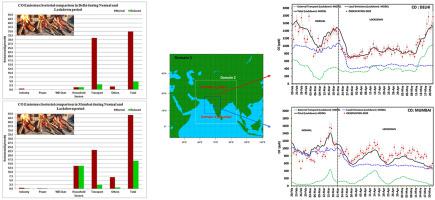Environmental Pollution ( IF 7.6 ) Pub Date : 2020-11-20 , DOI: 10.1016/j.envpol.2020.115993 Gufran Beig , Nikhil Korhale , Aditi Rathod , Sujit Maji , Saroj K. Sahu , Shruti Dole , R. Latha , B.S. Murthy

|
While local anthropogenic emission sources contribute largely to deteriorate metro air quality, long range transport can also play a significant role in influencing levels of pollutants, particularly carbon monoxide (CO) that has a relatively long life span. A nationwide lockdown of two months imposed across India amid COVID-19 led to a dramatic decline in major sources of emissions except for household, mainly from cooking. This initially led to declined levels of CO in two of the largest megacities of India, Delhi and Mumbai under stable weather conditions, followed by a distinctly different variability under the influence of prevailing mesoscale circulation. We hereby trace the sources of CO from local emissions to transport pathways and interpret the observed variability in CO using the interactive WRF-Chem model and back trajectory analysis. For this purpose, COVID-19 emission inventory of CO has been estimated. Model results indicate a significant contribution from externally generated CO in Delhi from surrounding regions and an unusual peak on 17th May amid lockdown due to long range transport from the source region of biofuel emissions in central India. However, the oceanic winds played a larger role in keeping CO levels in check in a coastal megacity Mumbai which otherwise has high CO emissions from household sources due to a larger share of urban slums. Keeping track of evolving carbon-intensive pathways can help inform government responses to the COVID-19 pandemic to prioritize controls of emissions sources.
中文翻译:

印度大都市COVID-19下家庭排放威胁的建模
虽然当地的人为排放源在很大程度上导致了地铁空气质量的下降,但是远程运输也可以在影响污染物水平方面发挥重要作用,尤其是寿命相对较长的一氧化碳(CO)。在COVID-19期间,印度在全国范围内实施了为期两个月的封锁,导致除家庭以外的主要排放源急剧减少,主要来自烹饪。最初,这导致印度两个最大的大城市,德里和孟买的CO水平在稳定的天气条件下下降,随后在当前的中尺度环流的影响下,CO含量明显不同。我们在此跟踪从局部排放到运输路径的一氧化碳来源,并使用交互式WRF-Chem模型和反向轨迹分析来解释观测到的一氧化碳变化。为此,已经估算了COVID-19的CO排放清单。模型结果表明,德里从周边地区产生的一氧化碳的贡献很大,而17日出现了异常的峰值个月之际锁定由于来自印度中部生物燃料排放的源极区域长距离运输。然而,在控制沿海大城市孟买的过程中,海洋风在控制二氧化碳水平方面发挥了更大的作用,否则由于城市贫民窟所占比例较大,孟买的家庭来源的二氧化碳排放量很高。跟踪不断发展的碳密集型途径可以帮助政府了解COVID-19大流行的应对措施,从而优先控制排放源。











































 京公网安备 11010802027423号
京公网安备 11010802027423号